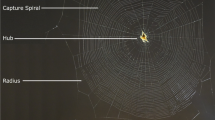Summary
Standard spider frames were continuously rotated in a vertical klinostat at different speeds, changed each day, in a rising sequence through 0.3, 0.7, 2.3, 4.9, 10, 20, 30, and 60 rpm. They were also rotated at various speeds between 100 and 150 rpm. Speed of rotation did have a marked effect on a number of web parameters. It is concluded that gravity is an important compass reference for orientation during web construction. The effect was greatest at medium speeds, and less pronounced not only at slower but also at higher speeds. The most striking effect was the complete disorientation of the spider during construction of the capture spiral at 5 and 10 rpm. Surprisingly no comparable disorientation was found in the auxiliary spiral. This suggests different orientation mechanisms for the two spirals. The ability to orient the capture spiral at high speeds may be due to the effect of centripetal forces, but it may also be attributed to an evolutionary adaptation to building in windy environments where the spider might experience linear accelerations of severalg.
Similar content being viewed by others
Abbreviations
- rpm :
-
rotations per minute
References
Crawford JD (1984) Orientation in a vertical plane: the use of light cues by an orb-weaving spider,Araneus diadematus Clerk. Anim Behav 32:162–171
Eberhard WG (1982) Construction behaviour and the distribution of tensions in webs. Bull Br Arachnol Soc 5:189–204
Eberhard WG (1982) Behavioural characters for the higher classification of orb-weaving spiders. Evolution 36:1067–1095
Finck A (1982) Gravito-inertial sensitivity of the spider:Araneus sericatus. Physiologist 25 [Suppl]: 121–122
Holzapfel M (1934) Die nichtoptische Orientierung der TrichterspinneAgelena labyrinthica (Cl.). Z Vergl Physiol 20:55–115
König M (1951) Beiträge zur Kenntnis des Netzbaus orbiteler Spinnen. Z Tierpsychol 8:462–492
LeGuelte L (1966) Structure de la toile deZygiella x-notata Cl. (Araignées, Argiopidae) et facteurs qui régissent le comportement de l'Araignée pendent la construction de la toile. Thèse, Publ Université de Nancy
LeGuelte L (1969) Learning in spiders. Am Zool 9:145–152
Markl H (1975) The perception of gravity and angular acceleration in invertebrates. In: Korhhuber HH (ed) Vestibular system (Handbook of sensory physiology, vol VI/1). Springer, Berlin Heidelberg New York, pp 17–74
Mayer G (1952) Untersuchungen über die Herstellung und Struktur des Radnetzes vonAranea diademata undZilla x-notata mit besonderer Berücksichtigung des Unterschiedes von Jugend und Altersnetzen. Z Tierpsychol 9:337–364
Peters HM (1932) Experimente über die Orientierung der KreuzspinneEpeira diademata Cl. im Netz. Zool Jb Physiol 51:239–288
Peters HM (1933) Kleine Beiträge zur Biologie der KreuzspinneEpeira diademata Cl. Z Morphol Ökol Tiere 26:447–468
Peters HM (1937) Studien am Netz der Kreuzspinne (Aranea diademata): I. Die Grundstructur des Netzes und Beziehungen zum Bauplan des Spinnenkörpers; II. Über die Herstellung des Rahmens, der Radialfäden und der Hilfsspirale. Z Morphol Ökol Tiere: 32:613–649; 33:128–150
Peters HM (1939) Über das Kreuzspinnennetz und seine Probleme. Naturwissenschaften 27:777–789
Sokal RR, Rohlf FJ (1981) Biometry, 2nd edn. Freeman, New York
Suter RB (1984) Web tension and gravity as cues in spider orientation. Behav Ecol Sociobiol 16:31–36
Vollrath F (1986) Gravity as an orientation guide during webconstruction in the orb spiderAraneus diadematus (Araneae, Araneidae). J Comp Physiol A 159:275–280
Vollrath F (1987) Altered geometry of webs in spiders with regenerated legs. Nature 328:247–248
Vollrath F, Mohren W (1985) Spiral geometry in the garden spider's orb web. Naturwissenschaften 72:666–667
Witt PN, Reed CF, Peakall DB (1968) A spider's web — problems in regulatory biology. Springer, Berlin Heidelberg New York
Witt PN, Scarboro MP, Peakall DB, Gause R (1977) Spider web-building in outer space: evaluation of records from the Skylab spider experiment. Am J Arachnol 4:115–124
Author information
Authors and Affiliations
Rights and permissions
About this article
Cite this article
Vollrath, F. Spiral orientation ofAraneus diadematus orb webs built during vertical rotation. J. Comp. Physiol. 162, 413–419 (1988). https://doi.org/10.1007/BF00606128
Accepted:
Issue Date:
DOI: https://doi.org/10.1007/BF00606128




